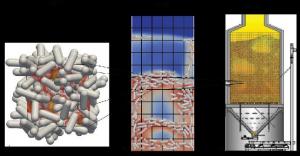Coarse-grained modelling of fluidized beds of non-spherical particles
This project is part of a larger ERC project in which quantitative understanding of the hydrodynamics of gas-fluidised systems of non-spherical granular particles will be achieved through a combination of modelling and experimentation, with an emphasis on modelling. The models range from detailed models of particle and fluid interactions, to more coarse-grained models, which use correlations obtained from the fundamental models, for large-scale applications. The models are validated experimentally, using state-of-the-art non-invasive techniques such as particle image velocimetry, digital image analysis and magnetic particle tracking.
In this particular subproject we will develop and implement the largest scale model. This model will be a coarse-grained particle-based model in which the dissipative particle-particle collisions are taken into account in an effective way through gradients in the particle stress. Generation and loss of fluctuating energy, caused by the dissipative collisions, are modelled separately. Constitutive equations and correlation functions are obtained from a combination of kinetic theory and more detailed discrete-particle dynamics simulations, in collaboration with other members of the ERC team.
Figure 1. Different levels of description of the gas-solid system, in order of scale, from detailed to coarse: Direct Numerical Simulations (DNS), Discrete Particle Model (DPM), and Multi-Particle Collision (MPC) model. In this subproject the MPC model is developed for simulations of large scale fluidized bed reactors containing elongated particles.
